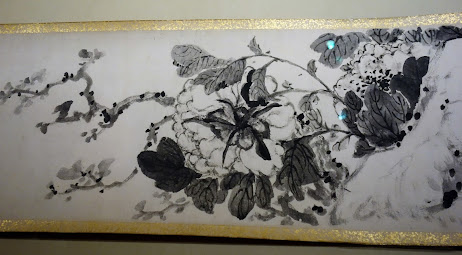We return to the Asian galleries of the Cleveland Museum of Art. If you were tiring of seeing so many images of Buddha, you are in luck. The next three galleries showcase the talent and skill of Chinese craftsmen and artists with not a Buddha in sight.
The first gallery is filled with objects from the Tang Dynasty which ruled from 618 to 907. This period is generally considered to be the high point of Chinese civilization, and the art of the era displays great sophistication.
This large, glazed earthenware horse was made around 700.
Celadon pottery is noted for its delicate jade-green color. This ornate, bird headed ewer was made in the 7th or 8th century.
A carving of a hare, sculpted from white marble, from the 700s.
Many earthenware figurines have been found in tombs. They provide us with a picture of the activities, attire and hairstyles of the time. Here we see a woman holding a plum blossom and a man playing the harp.
This pair of large, glazed earthenware figures once served as the fearsome guardians to a tomb. One has an animal face, the other a human face.
The adjoining gallery is filled with scroll paintings and pottery which show the love of Chinese artists for the flora and fauna of their country.
This hanging silk scroll from the late 1400s or early 1500s is painted with birds on a spring willow tree and amongst peonies.
This enameled porcelain jar from the late 1600s or early 1700s is decorated with flowers and pheasants.
This hanging silk scroll is called "A Hundred Birds and the Three Friends". Bamboo, pine trees and plum trees are referred to as "the three friends" because they persevere through the winter weather.
This is a portion of a long hand scroll painted on paper. It dates from 1741. It was done by an artist named Gao Fenghan who suffered an injury to his right hand and had to learn to paint with his left hand. As a result his paintings have very casual brushstrokes that distinguish them from the work of other artists.
The eagles in this painting from the Ming Dynasty (1368-1644) perhaps symbolize a wise emperor and his empress.
A Ming vase painted with lotus flowers.
The third gallery is a small space filled with exquisite pieces of decorative arts from 1300 to 1900.
This gilt bronze bell is from 1734.
A white porcelain figurine from the 1600s during the Ming Dynasty.
The detail in this small mountain scene carved from jade in the 1700s is incredible.
This table screen from the 1400s or 1500s is made of black lacquer inlaid with mother of pearl.
There is one more entry yet to come from the museum's Chinese galleries, a gallery devoted to Chinese porcelain. There is a reason why we refer to our dishes as china




















No comments:
Post a Comment